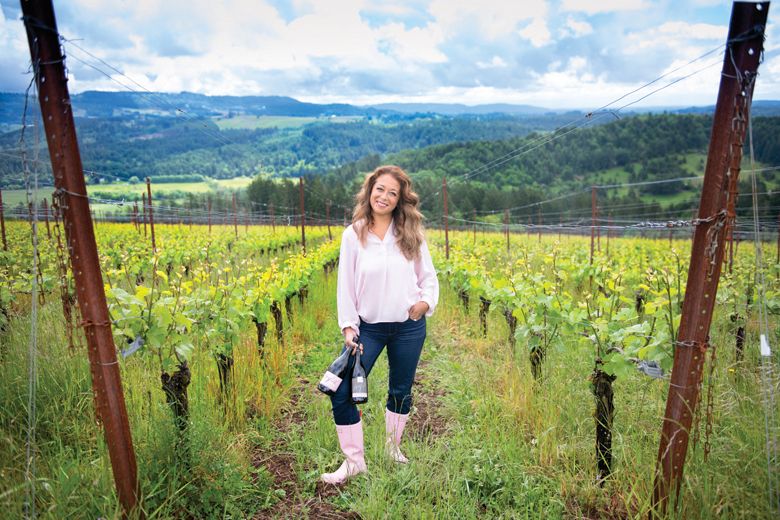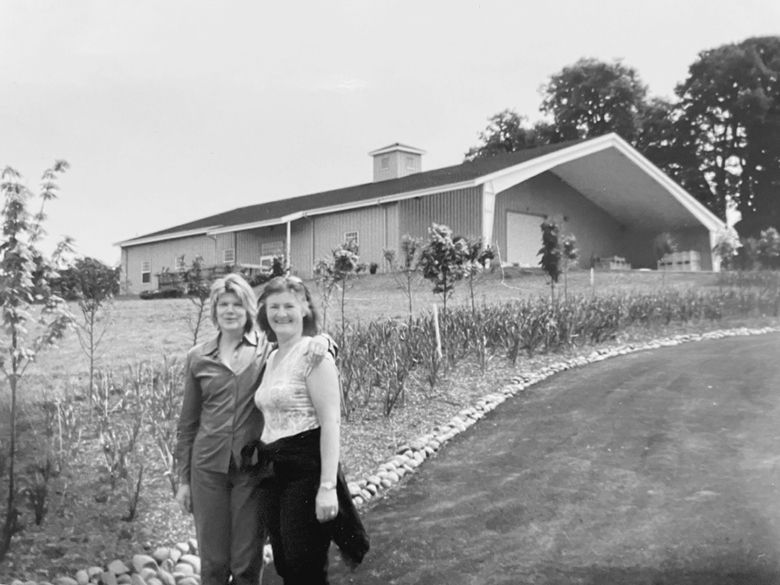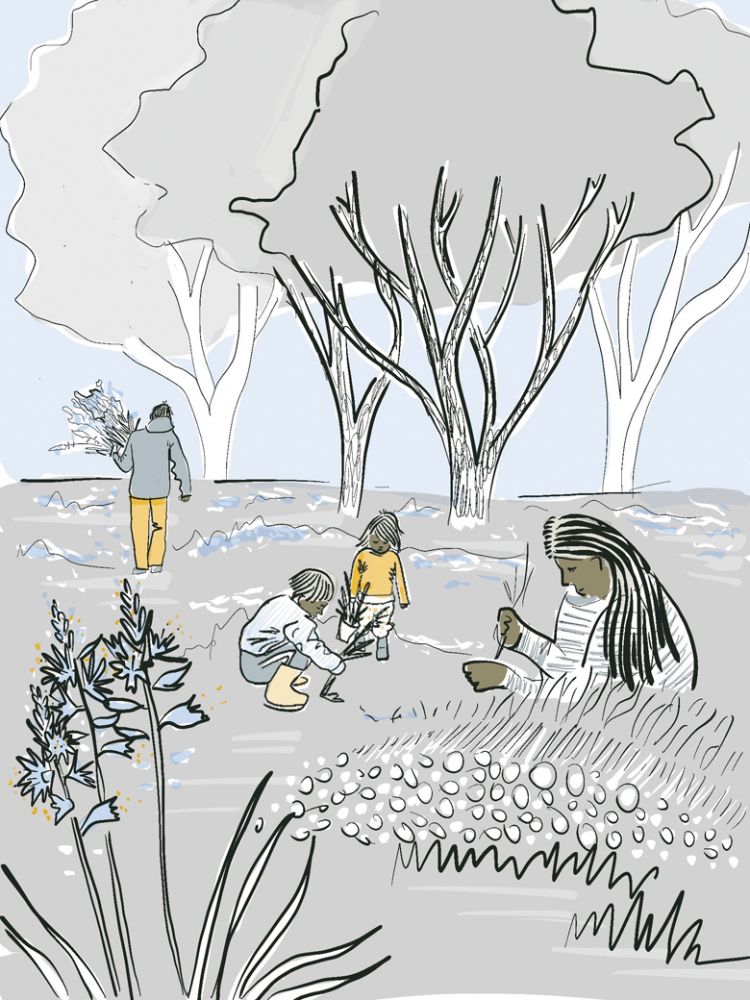Roaring Twenties
Seven wineries share advice and observations from the past 20 years














Story BY Jade Helm
This year (2022-2023), several prominent Oregon wineries celebrate their twentieth anniversaries of either first vintages or winery beginnings. To say much has changed in twenty years would be an understatement. In 2003, there were 13,400 acres planted; by 2021, that number had inflated to 41,899 (Oregon Wine Board’s most current count). The industry has grown from 673 vineyards and 201 wineries to over 1,400 vineyards and 1,058 wineries. While staggering, they cannot tell the “Muck® boots on the ground” stories experienced by the wineries during this growth.
A Little Background
Joe Dobbes, founder and co-owner Dobbes Family Estate and Wine by Joe in the Dundee Hills AVA, made wine in Oregon for 17 years before starting Dobbes Family Estate. “Between 1986 and 2002, the quality of Oregon wines increased dramatically, primarily due to increased experience, new clones and savvier site selection.” Dobbes explains this led to growth in recognition, volume, national distribution and outside interest and investment. “After over 30 years of the ‘modern’ era, Oregon wine suddenly became an overnight success,” Dobbes jokes.
Dobbes’ contemporary, Laurent Montalieu, winemaker and co-owner of Soléna Estate in Yamhill-Carlton (with Soléna Andrus Montalieu), moved to Oregon in 1987. He recalls, “It was still the first pioneers and winery families planting vineyards and winemaking, learning as they went along. Having made wine for others for a dozen years, he started Soléna Estate in what he calls the “third wave of the Willamette Valley industry.” He recalls mid-sized wineries popping up from existing industry professionals and people moving to Oregon. “In 2002, the wine industry in Oregon was rapidly growing, with plenty of opportunity and story still to be written,” reminisces Montalieu.
Skip ahead to the present and Dobbes feels, “The Oregon wine industry is now the place to be.” Which has led to some of the biggest changes noted by this group of vintners.
Biggest Changes
Recognition of Oregon Pinot Noir has soared, resulting in the influx of outside interest. “[Oregon’s] quality is highly regarded worldwide,” explains Dobbes. He points to investment by new and existing wineries from major winegrowing regions around the world. We have seen Jackson Family Wines, Santa Margherita and Louis Jadot (among others) purchase foundational wineries and vineyards. Montalieu also notes investments from large international wine businesses and conglomerates. There has been great expansion beyond the original founding families.
Jessica Mozeico owner and winemaker of Et Fille Wines in the Willamette Valley, remembers, “When I initially went out for distributor sales calls, I had to first educate about Oregon and justify why buyers should pay attention to our region. Awareness of the quality and growth of the Willamette Valley is [now] extremely high.” She notes the influx of “new players” from outside the state and country, “There’s a tendency to be cynical of that change,” she explains, “but I think these entrants bring a new skill set and marketing acumen (particularly in their distribution muscle) that we all benefit from as a region.” (Note: Howard Mozeico, Jessica’s father and Et Fille’s co-founder and founding winemaker, died in 2017.)
“The Oregon wine market is more saturated,” observes Tabitha Compton, co-owner with Matthew Compton of Compton Family Wines in the Willamette Valley. “The word is out globally that we have such an amazing growing region here. The growth has been great but quick— a big change.” Sheila Nicholas, owner of Anam Cara Cellars in the Chehalem Mountains, points out, “corporations and big money are more visible, reflecting the recognition Oregon wines have achieved on a national and international level.”
While some trepidation accompanies rapid growth and change, most see positives and hope much will remain the same. “So far, the unique spirit of the Oregon wine industry has continued to shine, and we hope the large winery investors will keep supporting that,” shares Montalieu.
Biggest Help
That “unique spirit” remains the recurring Oregon wine theme of collaboration over competition. Whether informal advice or organized tasting and marketing, generosity touched the success of these wineries from the beginning.
Nicholas recalls, “The first person who unknowingly mentored us was Susan Sokol Blosser of Sokol Blosser Winery. She introduced us to organic and biodynamic farming and didn’t hesitate to involve us in her world. No question we asked was too small or ridiculous.”
Mozeico found participation key to tapping into the industry’s collective knowledge. “Along the way, being part of collective groups like the Willamette Valley Wineries Association and International Pinot Noir Celebration helped us gain exposure we wouldn’t have received otherwise. Today, we are so fortunate to be part of the Willamette Valley wine community that is willing to lend a hand– because we know that rising tides lift all boats.”
In the “it never hurts to ask” category, Suzanne Larson, founder of Left Coast Estate in Van Duzer Corridor, called David Lett (founder of The Eyrie Vineyards) before sealing the deal on their land purchase. “We knew him only by admiring reputation, the Papa of Oregon Pinot,” Larson explains, “Yet, who picked up the phone but David himself?” Larson asked where Lett would plant. His reply turned out to be nearly exactly the site she had considered— today’s Left Coast Estate. “The kindness and generosity in that one telephone conversation have been returned again and again by so many others in this wondrous and unique Oregon wine community,” Larson explains.
Terry Brandborg, owner and winemaker with Sue Brandborg of Brandborg Vineyard and Winery in Elkton, began making wine in California in 1986. Seeking a place north to plant cool climate grapes, the Brandborgs credit relationships with pioneering Southern Oregon winemakers Richard Sommer of HillCrest Vineyard, Philippe Girardet of Girardet Vineyards & Winery, and Scott Henry of Henry Estate Winery. Their knowledge, plus advice from Earl Jones of Abacela, pointed them to the Brandborg’s site in Elkton.
Both Brandborg and Montalieu count the Steamboat Pinot Noir Conference as the opportunity to build winemaking skills and industry connections. Montalieu explains, “I had heard many wine regions claim to support cooperation in their local industry, but here in the Willamette Valley it’s actually true! It’s been very satisfying to be part of this camaraderie.”
Matthew and Tabitha Compton have taken up the reins to pay it forward in their community. “We frequently collaborate, working with other wineries in our Heart of Willamette Wineries group on projects and issues. The small town, neighborly feel of helping each other out by sharing resources and knowledge is very much alive and well.”
Biggest Points of Pride
Successfully starting and maintaining any business for 20 years is a huge achievement. Many define success beyond profitability. For Larson, it is her conservation efforts for white oaks. Mozeico is looking to the future, certifying Et Fille Wines as B Corp and building a sustainable business for her daughter’s generation. Montalieu also works with his daughter in mind. “I am proud we have been able to develop our 80-acre property into a functional and improved farming site, keeping it organic and sustainable. By doing so, I will pass on a thriving, long-term income-generating estate to my daughter.”
The Comptons are proud of how far they’ve progressed without much initial capital. “We started as a 400-case winery and grew into a 10,000-case winery distributing across the country.” Sarah Pearson, CEO of Dobbes Family Estate and Wine by Joe touts their commitment to the training and development of their employees. “It facilitates deeper trust between employees and departments, ultimately improving the experience of our people and the quality of our work,” explains Pearson. These positive outcomes extend into the community. Pearson elaborates, “The leadership team has developed an internal organization called ‘All Day, Every Day,’ or ADE, with a mission is to provide employees with opportunities to contribute to the betterment of our company and local community.”
Biggest Challenges
The short answer: weather! Nicholas can’t believe she remembers the specific weather each growing season. Larson says, “Each vintage in Oregon is extraordinarily unique… it’s a wild ride but worth the work.” Mozeico finds climate change and wildfire risk very impactful. “For example, I recently planted a vineyard at 1,000-feet elevation in the Chehalem Mountains AVA, previously considered too high to consistently ripen grapes.”
Biggest Surprises
Everyone knows that starting a winery is not for the financially faint of heart. Still, reality can hit harder than expected. Mozeico confides, “I’m glad we didn’t know how long it would take to pay ourselves, as we probably wouldn’t have been so tenacious.” Recalls Nicholas, “We were surprised at the cumulative cost to plant and grow grapes. When we opened our first bottle, we calculated its cost at $597.60!”
Obviously, all these wineries were able to weather financial phases. Dobbes is candid, “The biggest surprise for my own company was the fact that after starting with only $50,000 to my name and a $225,000 equipment, we became the second-largest producer of Oregon wine after only seven years in business!”
For some, success felt sneaky. Larson says, “We did not realize how successful we might be one day. In the early days, we took it one step at a time, learning as we went. We honestly didn’t even start thinking about our twentieth anniversary until a couple years ago. We’re proud to be here but certainly weren’t following a grand plan.”
Best Advice
With the idea of helping along fellow winemakers, these entrepreneurs offered some pearls of wisdom regarding hard work, clear direction, humility and relationships with staff and consumers.
Tabitha Compton advises, “Do your research, ask questions and support each other.” Mozeico promotes clarity of purpose, vulnerability to critique and patience. “Winemaking experience is cumulative,” she explains. “Every challenging vintage puts tools in your kit.” Montalieu believes a focus on quality and sustainability should be at the forefront. Nicholas warns to avoid greed, enjoy your wine club members and be pleasant to your interns.
Adding some levity, Larson reminds that while it is hard work, wine should also be fun “for you, your team and your customers.” And, of course, someone had to make the joke, “Start with a big fortune,” quips Brandborg.
While not technically advice, some candidly share a few examples they wish they had done differently. Montalieu would have planted new clones of Chardonnay much sooner in the original vineyard. “The variety is absolutely the new “Pinot Noir,” with critics and consumers alike taking note of how [Oregon’s] Chardonnay rivals the best in the world.” Nicholas would have attended more industry-specific business courses. “It’s not all wine dinners and stomping grapes. There’s plenty of paperwork and taxes.” Tabitha Compton learned to seek packaging and label advice from her distributors.
Next 20?
What can the Oregon wine industry hope for over the next 20 years? Nicholas and Larson sum it up perfectly. Larson shares, “We expect Oregon to continue to carve out an important place in wine lists and retail shelves across not only the United States, but the entire international wine market. Interest and investment in Oregon will continue as water security becomes more of an issue in California. I hope that we can continue to preserve Oregon’s unique identity as a region focused on the highest quality and authentic brands driven by real people.”
Nicholas agrees, “Because no two vintages are alike, Oregon will always be a place for winemakers with a true passion for their craft. Here they can live the challenge of creating great wines from whatever curveballs nature throws at them.










